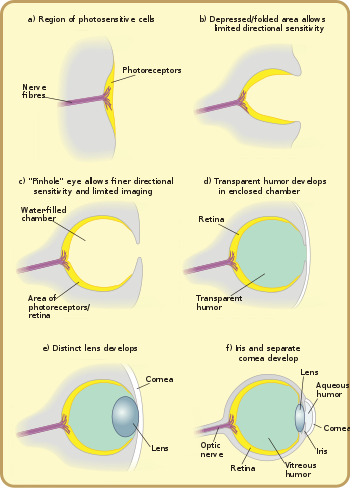
Back تطور العين Arabic تطور العين ARZ চোখের বিবর্তন Bengali/Bangla پەرەسەندنی چاو CKB Augenevolution German Εξέλιξη του ματιού Greek Evolución del ojo Spanish فرگشت چشم Persian Silmän evoluutio Finnish Histoire évolutive de l'œil French

Many scientists have found the evolution of the eye attractive to study because the eye distinctively exemplifies an analogous organ found in many animal forms. Simple light detection is found in bacteria, single-celled organisms, plants and animals. Complex, image-forming eyes have evolved independently several times.[1]
Diverse eyes are known from the Burgess shale of the Middle Cambrian, and from the slightly older Emu Bay Shale.[2] Eyes vary in their visual acuity, the range of wavelengths they can detect, their sensitivity in no light, their ability to detect motion or to resolve objects, and whether they can discriminate colours.
- ^ ""An important cue for understanding eye evolution is the distinction between different types of photoreceptor cells. Salvini-Plawen and Mayr ( 1977 ) noted a remarkable diversity of photoreceptor cell morphology across the animal kingdom, and suggested that photoreceptors evolved independently numerous times." – Land, M.F. and Nilsson, D.-E., Animal Eyes(2-nd ed.), Oxford University Press, Oxford (2012), p. 7.
- ^ Lee, M. S. Y.; Jago, J. B.; Garcia-Bellido, D. C.; Edgecombe, G. E.; Gehling, J. G; Paterson, J. R. (2011). "Modern optics in exceptionally preserved eyes of Early Cambrian arthropods from Australia". Nature. 474 (7353): 631–634. Bibcode:2011Natur.474..631L. doi:10.1038/nature10097. PMID 21720369. S2CID 4417647.
© MMXXIII Rich X Search. We shall prevail. All rights reserved. Rich X Search